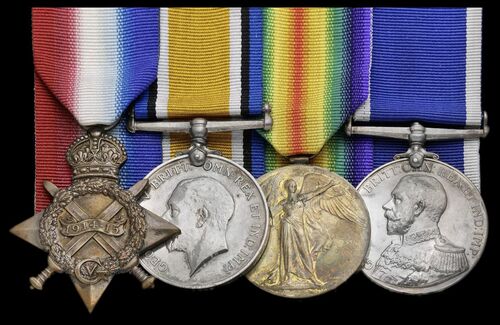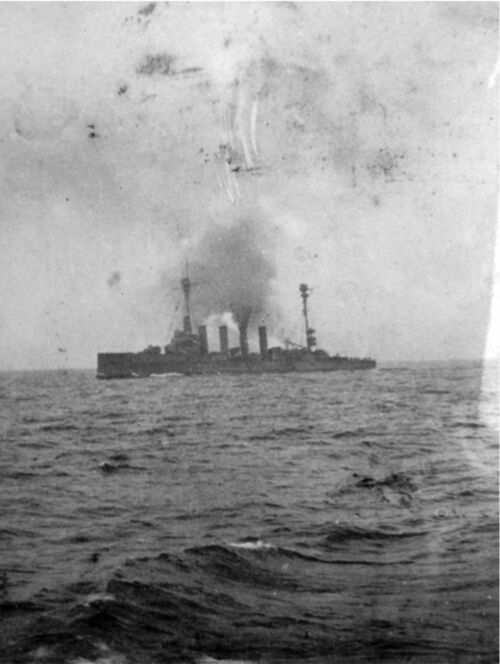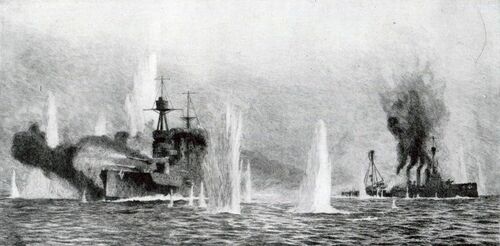Auction: 23001 - Orders, Decorations and Medals
Lot: 119
'The shell which drove the Senior Engineer Officer and his crew out of the starboard engine-room came through both engine rooms and burst at mid-line, leaving most of its gas in the port engine-room where I was. I was knocked down by the concussion, but got up and tried to see what could be done. I found it impossible to escape by any of the ladders, and as we were getting choked by the fumes and the steam we attempted to open the mid-line door to the starboard engine room. There we discovered that water was coming over the floor plates, that the crank pits were full up and the cranks were swishing round in the middle of it. Initially, I hadn't realised we were making water fast until a cold feeling around the ankles woke me up to the true state of affairs.
(The Engineer Lieutenant aboard H.M.S. Warrior describes the situation in the engine room after her hammering at the hands of the German Fleet)
Four: Petty Officer R. A. Osborne, Royal Navy, who survived the sinking of the pugnacious armoured cruiser Warrior after her headlong charge into the teeth of the German Navy at Jutland
1914-15 Star (183626, R. A. Osborne, P.O., R.N.); British War and Victory Medals (183626 R. A. Osborne. P.O. R.N.; Royal Naval L.S. & G.C. (183626 R. A. Osborne, PO. H.M.S. Glorious), minor contact wear, very fine (4)
Ruben Arthur Osborne was born at Plymouth, Devon on 6 November 1879 and entered the Royal Navy on 9 November 1899. Posted to Impregnable as Boy Class II he reached his majority aboard the battleship Magnificent, being appointed Ordinary Seaman on 18 September 1906. Further advanced Able Seaman on 28 September 1908 with the tender, Devastation and Leading Seaman on 7 February 1907 with Suffolk. Osborne passed the years before the Great War on a number of different warships and shore establishments including Andromache, Monmouth and Vivid I, being promoted Petty Officer with the latter on 1 November 1912.
Joining the company of the armoured cruiser Warrior lead ship of the Warrior-class, on 1 July 1913 and was still with her on the outbreak of war the next year. She opened the war in the Mediterranean, being involved in the pursuit of the Goeben and Breslau into Constantinople.
Joining a powerful French Fleet for a sweep which included the Adriatic, Warrior saw combat during the Action off Antivari on 16 August 1914. Here the Austro-Hungarian cruiser Zenta fought a heroic holding action to allow the escape of her consort Ulan. Though successful she was sunk by the guns of the far more powerful Allied Fleet.
After a period at the Suez Warrior joined the Grand Fleet as part of the 1st Cruiser Squadron. It was as part of that formation - Under Rear Admiral Sir Robert Arbuthnot - that she would sally out of port to join the Grand Fleet at the Battle of Jutland. As the British line 'crossed the T' of the German Fleet Arbuthnot launched a bizarre assault against the enemy. Launching his Squadron forward in a sudden charge out of 'Windy Corner' and directly at the German line. In the event only Defence and Warrior got through the British line with the others cut off by Lion which had to swerve to avoid ramming them.
They appear to have been attempting to finish the damaged Weisbaden but in the event all they managed was to expose themselves to the guns of the German Fleet. At least four heavy warships targeted them at once and Defence exploded under a barrage of 12-inch shells. This left only Warrior, alone and utterly outmatched before the leviathan battleships of the German Navy. It is estimated that she took at least fifteen shells in the ensuing minutes, attempting to turn and re-position.
Losing power and flooding Warrior appeared doomed until and astonishing stroke of luck saved her. The steering on the battlecruiser Warspite jammed and she veered out of line towards the crippled Warrior. Lurching in two full circles around the crippled vessel Warspite drew the fire of every gun in the German Fleet, the prize of a battleship being far greater than a cruiser. Unlike the cruisers however Warspite was equal to the punishment and despite heavy damage remained afloat.
Warrior was not so lucky, able to escape the fate of Defence thanks to Warspite's unexpected intervention she was still taking on huge amounts of water. Taken under tow by the seaplane tender Engadine the lighter ship was not able to take on the speed necessary and with a heavy heart Captain Molteno realised they wouldn't make port. An orderly evacuation of the crew - who had been suffering tremendously as the ship went down, particularly those in the practically submerged engine rooms - was soon underway. When all were safely aboard Engadine - the water being only 4 feet above below the deck at this point - the tow cable was cut and labouring ship finally foundered and sank off the Norwegian coast.
Osborne was reposted to H.M.S. Glorious after the sinking of Warrior on 13 October 1916. He saw action at the indecisive Second Battle of Heligoland Bight with her on 17 November 1917, here she was engaged only briefly, being hit once. Notably the worst damage Glorious suffered was self-inflicted, with a shell detonating prematurely and destroying the barrel of its gun.
Osborne remained with Glorious through her conversion to an aircraft carrier. He later transferred to the coastguard after the end of the war on 15 January 1920; sold together with a copied service record.
Subject to 20% VAT on Buyer’s Premium. For more information please view Terms and Conditions for Buyers.
Sold for
£260
Starting price
£80









